How to watch this site enjoyable? We wish we could lead you, need just a little longer. Instead, we try to show how to make the city enjoyable. Supposing that we can enjoy watching the urban surroundings either in big cities like Tokyo or in provincial towns. To that end, it needs to become aware of a point of view regarding it as object in the museum and play at the theater. And this perspective through the intellectual frame shows us another vision includes reality more exciting than all kinds of arts. Then don't just look at it but try to feel it.
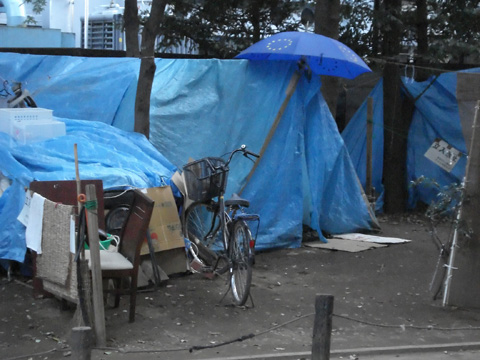
The men and women living under the blue tarps of Tokyo are homeless. Most of them lost work, shelter and the social environment all at once, not to mention the loss of status in Japanese society. In Japan homelessness is rarely the consequence of drug abuse ore other selfdestructing processes but mostly the result of a rapid economical downfall. For the affected persons this often means a sudden decreasement of living conditions. Sometimes they directly swap from the world of the black suit businessman into the life on the street. This is an explanation for their attempt to keep the living standards even there as high as possible. Two-thirds of the Japanese homeless are willed to work again and many of them are much more intellectual and educated as the society supposes them to be. But the biggest obstacle on the way to rehabilitation is the Japanese society itself, which usually tends to segregate the socially disadvantaged. Once the homeless people lost their reputation it can hardly be restored and the hope for a re-entry into the ordinary life disappears. There is improvement in Japanese law since 1999, but still the social support lacks.The homeless people react in generating own social structures and mutual aid. In this sense also their architecture, a paradox in terms of homelessness, seems now to be an icon of the unsheltered life. It is cheap and mobile and hence reduced to a minimum. A collage of materials like Paper, steel structure, timber and findings. However, the top layer always consists of the same material, a blue tarp which is combined to a multilayered waterproof skin. Beneath its functionality this material has become a symbol of homelessness itself, covering Tokyos parks.
In Shinjukus Toyama park there was an interesting shift in detail of one tent. It was marked with an umbrella in the blue colour of the European Union, showing the stars of the European flag. There is no evidence why the owner chose this symbolic umbrella to cover his house, probably it's just a coincidence. But it leads to some thoughts. Though the European Union was built on an economical foundation, it has become more and more a cultural union. Like the community of the homeless it has also a protective function and like the community of the homeless it was based upon a sad event, in the European case the First and Second Worldwar. Both systems are based on a lack of social and economical power. Considering nowadays situation in East Asia we should think about how a cultural and protective union could be built without that tragic event that connected the people in Europe and in Toyama Park.
We left the city and entered the Toyama park nearby the laboratory. It seemed to be an oasis of the naturalness. A place to enjoy and relax from the stress of the everydaylife of the city. The Nature is here, at least a little bit.
We can see the trees, the bushes and hedges.
We can hear the sounds of wind, birds and some people walking on the sand.
We can smell the flowers, the grass and the wood.
We can feel the nature in its place...
Something strange, not everything seemed to look as peaceful. What is it?
If we take a closer look, we can see the appearence of steel in the the dress of cutted wood. In other sites, for example in Nikko, one of the treasures of japanese culture, we can have an experience with plastic-wood by walking on it, in the middle of the world heritage.What is it, that makes us produce such strange imitations of nature?
Can it be cheaper than reality? If we think about the restrictions of the material itself we can come to the point, that wood can be grown, but plastic or steel is in the touch of an industrial process with a limited use and a much more long timespan in entering the natural cycle. Is this a possibility of the past, the present or even the future?Even the haptical appearence of the copied material is far from being nice.
I have to admit the copy is good and it looks on first sight as the original, but this is something which makes it just more untrustable. In our thinking it is enough to let things look like a feeling. In the age of modernity we started to use industrialized products and increased the number into endlessness, but now, for the 21st century i would like to ask, if we not have to come back, closer to nature and use the industrialization where it is a need and useful. Possibly we went one step too far.The reality wears a costume and this is the ridiculous, but demoniacal one of a harlequin.
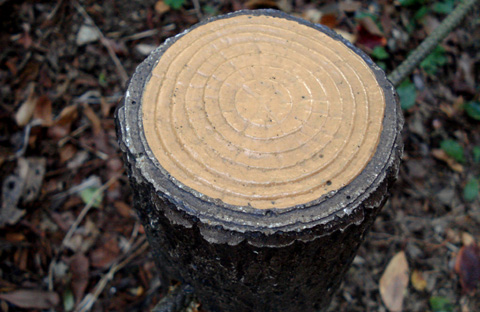
On the edge of Toyama park we stepped in the housing and commercial area in the range of Takadanobaba station. The first building we met is a 12 floor dwelling house. A concrete building, maybe built in the 70s or 80s. The first floor of the street facade is filled with shops and restaurants. In this time of the day, the shops already put on the luminous advertising.
Inbetween these we can find an unlighted place. The appearance is strange, it is a usual window of the area, closed with a blue curtain and above is a wooden plate with small letters telling us ĀčRudolf Steiner Haus JapanĀč. A little postbox and some posters as a sign of motion.The place seemed to be strange, in the middle of somewhere, in any faceless building of the last century, if we compare to the Goetheanum in Dornach/ Switzerland. Does it fit the keypoints of Steiners teachings, the antroposophical tenet?
Our first walk came to my mind and i remember two of the child teachers of the ĀčAbenteuerspielplatzĀč in Toyama park told me about a trip to Germany to study about the concept of Rudolf Steiner schools and the idea of Kindergarten.
After coming back to laboratory i found the homepage of the Antroposphical society and i could read about the global network of the houses. Like in Takadanobaba it exists in more than 78 other countries, with the mainbase or ĀčsoulĀč in Dornach. By e-mail i asked about the work of the society in Japan. No answer yet, so the motion seemed to be very slow.
Mainly the work is to organise workshops, including art and theory.After thinking about the situation of the house in Japan and rereading some texts by Steiner himself, i still wonder about his sofisticated idea in the early 20th century. Within the progressive Industrialisation, the orientation and the significance of life came more and more to the individual person. Entirely our existence arrived at ourself.
Maybe it is a good point to set the stage of the theory of philosophy, art and paedagogy, based on the human being itself [antroposophical theory], in the center of dusty capitalism, the twilight of modernity as a result of growing economy. The Steiner Haus and its surrounding seemed to be in antagonism, but in my opinion they are mutually dependent.

In Tokyo vending machines on every corner are already taken for granted. But despite their functional aspect, they include as well some interesting comments on contemporary Tokyo and its achievement-orientated society.Every single vending machine with its own special range of beverages is an autonomous object, run by several different companies. But in the density of their appearance, a network forms that overlays the single object. There is a big difference in comparing it to the historical concept of a marketplace. Where in the past the action of buying was linked to a dedicated place, now it doesn‘t matter where you are situated. Moving through the streets of Tokyo be sure to discover vending machines everywhere you expect them to be. Within this non-hierarchical horizontal netting lies also a connection to our information society. Information is available almost everywhere. To achieve this, apparently the media changed. The media, that can be as well architecture, the inhabitants or a vending machine. As networks always implie a widespread distribution of nodes, serialization is obvious. In Tokyo you can feel the networks as much as the resulting serialization. For the complexity of a city like this, the concept of decentralized networks emerged as the most suitable. You can see similarities in the decentralized urban plan of Tokyo or the system of Koban and adresses.
Nowadays we should ask ourselves how the sorrounding networks take influence on us and how we can avoid the serialization within this systems of nodes.To be unique the recent vending machines follow the concept of "more is more". Bright lightened they are noticeably praising themselves with extra advertisement for the drink of the week. In the night you can see the buttons blinking to the rhythm of an inaudible beat. It‘s a factoid individuality of a superficial surface, which is addressing the common people of a highly competitive society. Hence the bigger part of the sold beverages are coffees and artificial energydrinks with lots of added vitamins. Like paying a coin for an Omikuji-paper at a temple or in a coffee house, people are used to the little efforts in life you can achieve with a small amount of money. But who needs the vitamin c amount of 50 lemons a day? And more important, what was first? The vending machine or me, throwing the coins? In the end with a 24h-vending machine around every corner, at least there is no excuse to be ever weak or tired again.
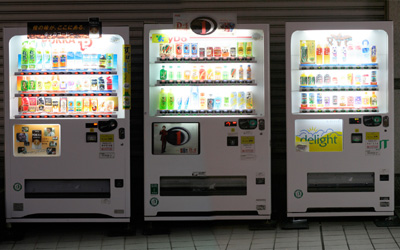
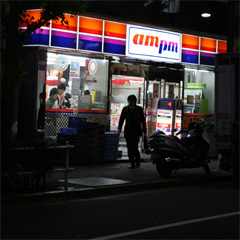
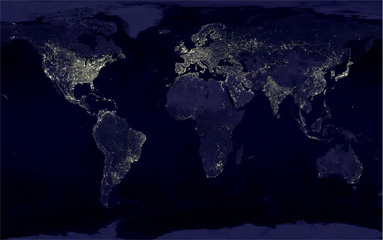
One month ago I had to travel for a couple of weeks to South America, Chile. Coming from Tokio it was very clear the difference about the energy consume. Our Latin American cities works in the night with half consume of light if we compare with the cities of the 1st world. In Santiago I had the impression that the environment was a mixture between urban and countryside. The city escape in the night was weak and fragile.
I think that the definition of a metropolis is not only about infrastructure, accessibility or connectivity to the physical networks. The scale of a metropolis is possible to be measure also by “the incandescence of the night escape”. In the night, a city without light it doesn’t exist.
In the airplane over Phnom Penh it looked like no light in the ground, remembering the ghost aspect of 30 years ago. However in its streets I could feel a strange and powerful energy. Everything was active there in the darkness. When we take a walk is possible to find smalls shops which open 24 hours like the Tokio’s convenience stores, but in the darkness....
The convenience store had became a symbol not only of the fast consume in the stressful urban life of the modern world, but also as a terminal connection with the global information network, in the physical level and the virtual one.
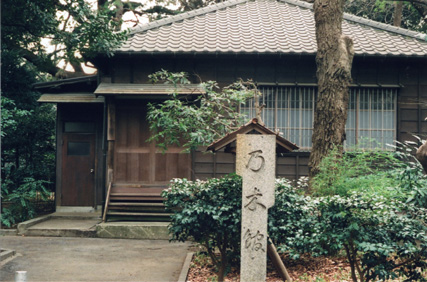
In the spring break of 2002, I waged my first try to go for a stroll in the gakushuin campus, an unsuccessful attempt, for the seimon security officer with blue uniform could tell immediately that I was a gaijin. Raised his arms with both forearms crossed, very politely with a long story in Japanese he advised me not to get in, lots of a-no, de and ne sounds, bowing with a regrettable facial expression, and I bowed back, with smile, a natural kind of course. Perhaps I should have hung my M-4 with Summicron 35mm/f 2.0Ā\things might just have changed a bit. Never-the-less, today, Jan. 24, 2007, I did break through the blockage under the covering of a pride of handsome gakushuin students coming out of the mejiro eki, stepping through the west gate.
I came to Tokyo in 2002 to learn architectural design, or, to steal a parchment kind of paper more likely, and, with a true intention to satisfy my curiosities long embedded in my skull since childhood. Because of the Japanese colonization, my parents both speak Japanese and do so even today. Perhaps at 10, I vaguely remember, my uncle, my mother side, was sent by the bank he worked in Taipei for a shucchou to Tokyo in the 60s when Taiwan had been under severe marshal law. Japanese movies, for instances, were banned in the 70s and 80s, traveling abroad was a hard issue with lots of governmental paperwork. He came back with a Toshiba rice-cooker with a transparent plastic concave right beneath the handle of the rice-cooker cover, a Nikon camera with trace of Contax IIIa and a Yashica with rolleiflex look. They did make tasty rice and good photos. Also, Kobayashi Akira was my hero, saving cute girls from beating up nasty guys. As my brain got grown sophistically, somehow I had an impression that the Japanese sense of beauty, quite often, seemed to go hand in hand with sorrow. The Zengakuren chaos, for instance, between the armed police force and the students wearing big white mouth-muffle in Toudai had been aired in the then Taiwan TV, followed by Mishima Yukio's final episode in the end of 1970, and, in 1973, as I was struggling to get some college education, my ears had been stuffed with a ceaseless talking topic among my parents and their friendsĀ\that Yoshinaga Sayuri married a 40-year-old-n-funny Fuji TV director, and last but not the least, he was a second-hand bachelor. "She should at least marry a medical doctor," said my mother. That "it is unfair" was thus their conclusion. My heart sunk as well; despite of my dumb puberty age I can sense the sorrowfulness accompanying with regret. O.K. Enough! Switch channel to the gakushuin topic.

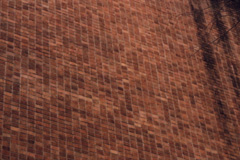
Why did I in March 2002 wish to see gakushuin? There are 2 reasons. First, I was at my first glance impressed with the style of the gakushuin seimon. It seems that an institutional Japanese building complex usually has the seimon designed to express her identity. My favorite seimon design is of the Toudai komaba. Stepping out of the inogashira densha gate, I faced the seimon immediately and got reminded of the Japanese Imperial House by the pair of huge heavy wood-built wall-like door with the engraved chrysanthemum patterns, which projects a touch of the Japanese sense of sublime mixed with elegance. The Akamon gate in Hongou magnets me to step through with the same power as well. Gakushuin's old brick buildings seem to share the same style with her counterparts in Toudai. The scraped stone walls of the rigakubu, I wonder, were done by the same drama carried out by the Zengakuren who contributed the scraped stone walls of the Yasudakoudou. Also, the dark-red brick walls of the old buildings somehow evoked my admiration of the aging brick buildings of the Cambridge University, England, particularly that of the Queen's College. Arguably though, the white pyramid-like lecture hall is perhaps a bit too eye-catching to suit her surrounding brick buildings.
My second reason was personal, that Mishima Yukio graduated from the gakushuin koutouka. Threading through the building complex down to the south area, excitingly, I saw the horse riding society established in 1878 right below the back slope of Nogikan, a residence for the then gakushuin principal Nogi Maresuke(1906-12). I believe he had spent his last 6 or 7 years in grief, praying peace and relief for the killed soldiers, both of the Japanese side and the Russian as well, apart from his daily duties for the gakushuin. A well-preserved washiki house without any decorative appearance except for a pair of stone tablets nearby engraved with hard-to-read kanji perhaps about his military career, surrounded by the trees planted maybe by the Marshal himself. Was this the place he and his wife committed the act to follow the Meiji Emperor? I chanted a few lines of kannon sama for the dead. A student-like skinny young man jogging through the surrounding woods, I followed his stone slab jogging path descending to the stable, a couple of good-looking boy and girl, wearing rain coat, were washing the horses; the girl was trying to wash off the dirt from the horse shoes by holding up the rear legs, yelling and slapping the rear trunk of the animal that were uncooperative. The boy chuckled out loud cheerfully. 12 horses were there altogether. Perhaps a hundred years ago the cavalry cadets were trained here; yet today it reminds me of the story narrated in the novel by Miyamoto Teru and of the TV drama aired last year, a romantic story about a young girl. Again, a teen-ager girl with innocent beauty mixed with sorrowful or, perhaps melancholy personality, breeding and taking care of the racing horses in the ranch, I don't need to guess the result of that romance.
A clean and crisp campus radiating moody dignity with elegant history, Gakushuin expects her students not only to grow up with scholarly senses but to glow with noble sensibilities.